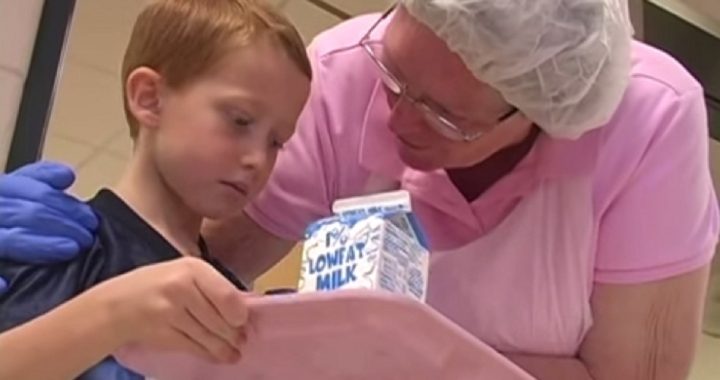
Jeffco Public Schools, a school district in Jefferson County, Colorado, was facing the same problem as countless other districts across the nation: Students didn’t want to eat their new, federally mandated “healthy” lunches. Unlike some other districts, however, Jeffco came up with a solution: Bribe kids into buying lunch.
“With all the new regulations and the changes that we’ve made, our lunch participation has gone down,” Jeffco Schools lunch facilitator Lori Burris told Denver’s KUSA-TV. “So, this was to be an incentive to try school lunch and maybe bring them back.”
The “new regulations” to which Burris referred are, of course, the school-lunch standards championed by First Lady Michelle Obama and written into law via the Healthy, Hunger-Free Kids Act of 2010. Schools participating in the National School Lunch Program (NSLP) must adhere to these standards or forego their federal school-lunch subsidies.
Among other things, the standards require school lunches to contain more whole grains and fruits and vegetables, less fat and salt, and fewer calories than lunches that were previously being served. They compel students getting a school lunch to take a serving of fruit or vegetable whether they want it or not. And they don’t just apply to lunches: Vending-machine and bake-sale wares also must meet with Uncle Sam’s approval.
Not surprisingly, the requirements have met with stiff resistance. According to a Government Accountability Office report, over one million students unhappy with the food offerings or the meager portions have stopped buying school lunches, many opting instead to take their own lunches to school (although even packed lunches have been rejected by some schools for failing to measure up to the guidelines). Others have protested, with students at one high school even registering their complaints via YouTube. Still others have reluctantly accepted the lunches but thrown away much of the food; a recent Harvard School of Public Health study found that 60 percent of fresh vegetables and 40 percent of fresh fruit — and, by extension, the taxpayer dollars spent to furnish them — are being wasted.
As a result, hundreds of schools have simply dropped out of the NSLP. For many of these schools, adhering to the new standards — even with the subsidies attached — was a losing proposition, sometimes to the tune of $100,000 or more.
For its part, Jeffco Public Schools saw its school-lunch sales drop six percent in 2013.
“We think it’s because they [students] don’t necessarily like some of the new changes that we’ve had to make,” Burris told KUSA. “The food is much healthier. We are lower in salt. We are lower in fat. We have more grain. We have more fresh fruit and vegetables, but it takes a little while for kids to get used to that.”
Burris decided to entice kids into buying lunches again in hopes that they would try the new food and find that “it really tastes good,” she said. “It’s just different.”
She created the “Hungry to Win” contest, “a raffle where students are entered to win prizes just for ordering a school lunch at any school in the district,” reported KUSA. There are drawings for “smaller prizes like jump ropes, kites, movie tickets, and iTunes gift cards” plus “grand prizes of bicycles and iPods,” the station explained.
What kid wouldn’t endure a school lunch — even one of the newfangled, allegedly more healthful ones — for a chance to win one of those prizes? Indeed, Jeffco’s lunch sales have bounced back significantly, up four percent over last year. In fact, the first “Hungry to Win” contest was so successful that the district is planning another one for the spring.
Not everyone is happy with this approach to getting kids to eat school lunches.
“This is amazing!” remarked one commenter on the KUSA story. “Jeffco is teaching our kids how to gamble! Not just to gamble, but to gamble to eat. Is the next field trip to Las Vegas so we can teach them how to live on the streets after they don’t win? ‘Hey, buy our food and you could win a bike!’ or ‘Hey, play our slots and you could win a car!’ What’s the difference?”
It’s worth noting that the prizes in the “Hungry to Win” contest are, according to KUSA’s video report, “provided by food suppliers,” who just might have an ulterior motive in encouraging students to buy more food.
Jeffco isn’t the only school district in the country to try bribing students to buy lunch. A Richmond, Missouri, district recently announced that students who bought school lunches would be eligible to buy (Washington-approved?) ice cream for one dollar on Fridays.
“We will not be offering this to the kids who bring their lunch from home because we are trying to get them to eat our school lunch, and to also help our school lunch program, which also helps our school district,” the memo to parents read.
According to Kansas City’s WDAF-TV, that memo “was sent out without district approval by Opaa!, the third-party food management company that provides school lunches” — yet another instance of a private company’s standing to profit from encouraging increased school-lunch sales. The district later expanded the program to include all students after parents complained.
Clearly the current NSLP guidelines are not working, or schools would not have to entice students into buying lunches. The solution, however, is not to reform the guidelines or to return them to their pre-2010 state. It is to abolish the unconstitutional NSLP and leave school-lunch programs up to states and school districts. Then again, considering the rate at which schools are abandoning the NSLP already, the program may well die from attrition. If so, the politicians who foisted the Healthy, Hunger-Free Kids Act on America may find the outcome of their legislation as distasteful as the food they’re putting on kids’ plates.
Photo: screengrab from YouTube video We Are Hungry.



